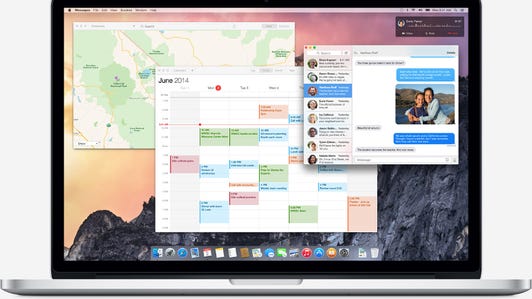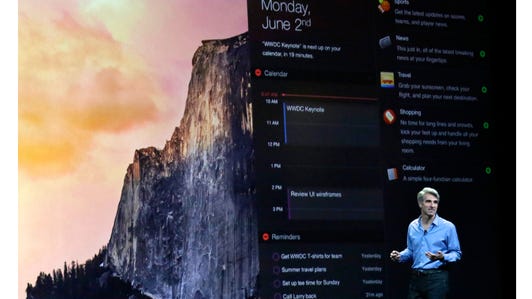Apple has the chance on Thursday to provide a few compelling reasons for consumers to upgrade or buy a new iPad.
The company’s second event in just two months won’t have the flash from the previous affair, which saw the debut of two larger iPhones and a glimpse at the Apple Watch. Instead, the company is expected to show off a new iPad (or two), unveil new Macs and talk more about its OS X Yosemite operating system for its desktop. The presentation, which kicks off at 10 a.m. PT, is a lower-key affair held at Apple’s headquarters in Cupertino, Calif.
While the iPhone remains Apple’s dominant revenue engine — contributing to more than half of its sales — the company is eager to bolster its other businesses. Front and center will be a new version of the iPad, which faces questions over whether its declining shipments are a temporary hiccup or a troubling trend. The question for the tablet has continued to shift from “What nifty new feature will be on the new iPad?” to “Do I really need to replace my aging — but still functional — iPad?”
Apple’s iPad event: Tune in to our live blog Oct. 16
Its performance over the last two quarters, in which sales declined over a year ago and fell below Wall Street expectations, is illustrative of that kind of mentality. And the trend is expected to continue in the most recent quarter, which Apple will report four days after the event. Adding to the pressure are the raft of cheap tablets that have flooded the market.
Related stories
- Apple’s iPad event: Join us Oct. 16 (live blog)
- The Apple Mac update report card: October 2014 edition
- Apple’s iPad sales are not so magical after all
Apple wasn’t the first company to create a tablet, but it was the first to make a model that really caught on with buyers. The sleek design, app store and touch screen capabilities on the first iPad, introduced in 2010, attracted millions of buyers to the device. iPad grew into a huge revenue driver for Apple — the tablet’s currently its No. 2 moneymaker after the iPhone — and everyone from Microsoft to Xiaomi has built copycat devices.
But Apple hasn’t made big enough changes to the iPad to compel even its most ardent fans to immediately buy the newest model. “What I’ve consistently found in research is tablets are nice to have but not something [people] need to have,” said Bob O’Donnell, chief analyst at Technalysis Research. “If the iPad Air didn’t move the needle — and it was a pretty decent upgrade — I don’t know what’s going to.”
Even though the iPad will be the most anticipated news Thursday, there almost certainly will be Mac updates, as well. That includes new hardware and Apple’s latest computer operating system, Mac OS X Yosemite. Even though the Mac doesn’t make as much money as the iPad, the computers remain important to Apple’s strategy.
Here’s more information on what we’re likely — and unlikely — to see at the event.
iPad Air gets the spotlight
More than four years (and seven models) after introducing the first iPad, Apple’s sleek device remains the king of tablets. In the second quarter, Apple shipped 13.3 million iPads, giving it a market share of 27 percent. But its position has been slipping versus rivals; a year earlier, Apple’s market share was 33 percent.
The company needs a new model of its popular 9.7-inch device to revitalize iPad sales. But the updates coming Thursday are expected to be incremental changes instead of a revolution.
One likely addition to the iPad Air is the TouchID fingerprint sensor, which first popped up in last year’s iPhone 5S and appeared in the new iPhone 6 and 6 Plus. It allows users to unlock their devices and purchase items in iTunes with the touch of a finger.


Now playing:
Watch this:
New iPads, Macs and OS expected to debut at October Apple…
3:07
TouchID also will soon work with Apple Pay, the company’s new mobile payments system unveiled at its September 9 iPhone 6 event. Apple likely will allow the iPad to take advantage of some Apple Pay features when the service launches later in October. That includes letting people pay for items in apps using a single touch on the fingerprint sensor.
It’s less likely that the iPad will include a near field communication (NFC) chip that allows users to pay for items in retail stores by tapping their devices on a point of sale terminal — you would look pretty silly trying to wave your iPad at a cash register.
Another likely update to the iPad is a gold model, also following in line with Apple’s recent iPhones. The iPhone 5S was the first device to offer that particular color. Along with gold likely will be silver and space gray versions.
And the iPad undoubtedly will feature new components, such as Apple’s A8 processor. The iPad could get the same kind of storage bump as the iPhone 6, dropping the 32 GB and going straight from 16GB to 64GB and 128GB. The company already offers a 128GB iPad, but it’s a $300 premium over the $499 base model. If brought in line with Apple’s iPhone pricing, that tier could get a $100 cut in price.


CNET
The company also will probably update the camera and include a higher resolution screen — a key feature as competitors have stepped up their game with display technology. The screen may include an anti-reflective coating that makes it easier to see.
The new iPad Air will also likely be thinner and lighter.
What’s unlikely is the appearance of a bigger screen iPad, which many have dubbed the “iPad Pro.” The device, which market watchers believe could have a 12.9-inch screen, probably won’t be announced until next year.
The iPad Mini, Apple’s 7.9-inch tablet, could see some small updates, but much of the focus will be on the bigger device. Part of Apple’s iPad struggles have come from consumers replacing smaller tablets with bigger phones — typically, phone-tablet hybrids called phablets.
Apple introduced its first phablet, the 5.5-inch iPhone 6 Plus, last month, and some analysts expect consumers to opt for that instead of an iPad Mini. “The iPhone 6 Plus is almost crossing over into tablet territory, and there’s a possibility that will impact … demand for the iPad Mini,” Creative Strategies analyst Tim Bajarin said.
The Apple Mac update report card: October 2014 edition






Macs finally get some love
Apple’s Mac business might not be as big — or as sexy — as its mobile business, but it remains an important focus for Apple. Apple now generates less than 15 percent of its revenue from Macs, but the devices help flesh out its family of products — which are increasingly designed to work together.
Apple in July reported Mac unit sales rose 18 percent to 4.4 million in the quarter ended June 28. CEO Tim Cook said the Mac boosted Apple’s overall financial results, and the company saw strong sales in some regions weak for other PC makers.


CNET
Apple hasn’t yet reported its most recent quarter, but research firm IDC last week said the company moved into the No. 5 ranking for global PC sales in the calendar third quarter. For the past several years, Apple has controlled a much smaller chunk of the market, but its sleek designs, such as the MacBook Air, have attracted customers.
Apple last year introduced its powerful Mac Pro, and it has continued to add Retina Displays to its various MacBooks. But there also have been some devices that haven’t been updated in years.
One product long overdue for an update is the Mac Mini, which hasn’t been refreshed for two years. The device is Apple’s most affordable computer, ranging in price from $599 to $999. An owner must also purchase a display, keyboard, and mouse for the device to work, and the most expensive version of the box also works as an OS X server. It’s likely the Mac Mini will be updated with Intel’s newest processors and more internal storage.
Another Apple computer in need of an update is the iMac. The all-in-one device, with the brains hidden behind a sleek display, hasn’t had a design change in two years. Most of all, its screen resolution hasn’t changed much while other devices have been bumped to Retina Displays. The iPhone 4, introduced in 2010, sported the first Retina Display, while the higher-resolution screen hit the iPad and MacBook Pro line in 2012.
It’s unlikely that Apple will introduce a MacBook Air with a Retina Display, though consumers have been clamoring for such a device. The company updated its thinnest and lightest laptops with new processors and a price cut in April. It’s also unlikely that Apple will incorporate its TouchID sensor into its computers this fall, though that’s something we could see in the future.
A second visit to Yosemite
Apple unveiled the latest version of its computer software, OS X 10.10 Yosemite, in June at its Worldwide Developers Conference in San Francisco. The operating system has a new look, a refined toolbar, new notification-center features and a dark mode. In addition, Yosemite will now synchronize with Apple’s iOS mobile operating system through AirDrop file-sharing, iMessage messaging and the ability to make and take phone calls.”All in all, they come together for a gorgeous and more usable version of OS X, the best ever,” Craig Federighi, senior vice president of software engineering, told developers at the conference.
Apple undoubtedly will show off Yosemite on Thursday and talk up the ways it interacts with the iPhone and iPad. The company could also discuss iCloud and other software for its devices.
To build customer loyalty and make sure users are accessing the most recent software, Apple last year made Mac OS X 10.9 Mavericks free for download. Yosemite also is free for users, and it’s likely Apple will release the software to the public following its event Thursday.
Tune back to CNET for full coverage from Apple’s event. We’ll start things off with a live show at 8:45 a.m. PT featuring Brian Tong, Donald Bell, Sharon Profis and Stephen Beacham. They’ll respond to viewer calls, tweets and emails and feature live reports from Cupertino before handing it over to the reporters on site. Apple’s presentation starts at 10 a.m. PT, and we’ll be bringing you all the news and commentary from inside the venue.
A closer look at Apple OS X Yosemite (pictures)









